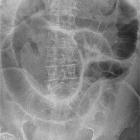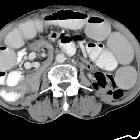intestinal volvulus















Intestinal volvulus is a broad term that describes the torsion of bowel around its mesentery. Torsion results in narrowing of the lumen at the point of rotation and compromise of the vessels that supply the torsed gut.
In order for a vessel to be compressed and obstructed, the force that the torsion imparts on the vessel needs to be greater than the pressure of blood within. Hence, the first vessel to be compromised is the vein resulting in venous stasis with mesenteric injection; if the torsion is not corrected venous infarction and bowel perforation may occur. Depending on the torsion, arterial compromise may occur causing frank bowel ischemia.
Pathology
Within the abdomen, there are 4 main mesentries and hence, 4 types of volvulus:
Sigmoid volvulus is the most common, accounting for 60% of cases of intestinal volvulus .
Radiographic features
Radiographic features are specific to the distinct types of volvulus, but on CT they generally demonstrate the whirl sign.
Siehe auch:
- Kaffeebohnenzeichen
- Mesenterialinfarkt
- Whirlpool-Zeichen
- Sigmavolvulus
- Volvulus des Coecums
- Mesenterium
- Dünndarmvolvulus
- Magenvolvulus
- Volvulus bei Kindern
und weiter:
- Dünndarmileus
- upside-down-Magen
- Askariden
- organo-axial gastric volvulus
- mesenteroaxialer Magenvolvulus
- intestinale Malrotation mit Volvulus
- DIOS
- intestinale Malrotation ohne Volvulus
- internal hernia complicated by small bowel volvulus
- intestinal venous infarction
- Malrotation mit Dünndarm-Volvulus
- transverse colon volvulus due to Ladd's band

 Assoziationen und Differentialdiagnosen zu Volvulus:
Assoziationen und Differentialdiagnosen zu Volvulus:




